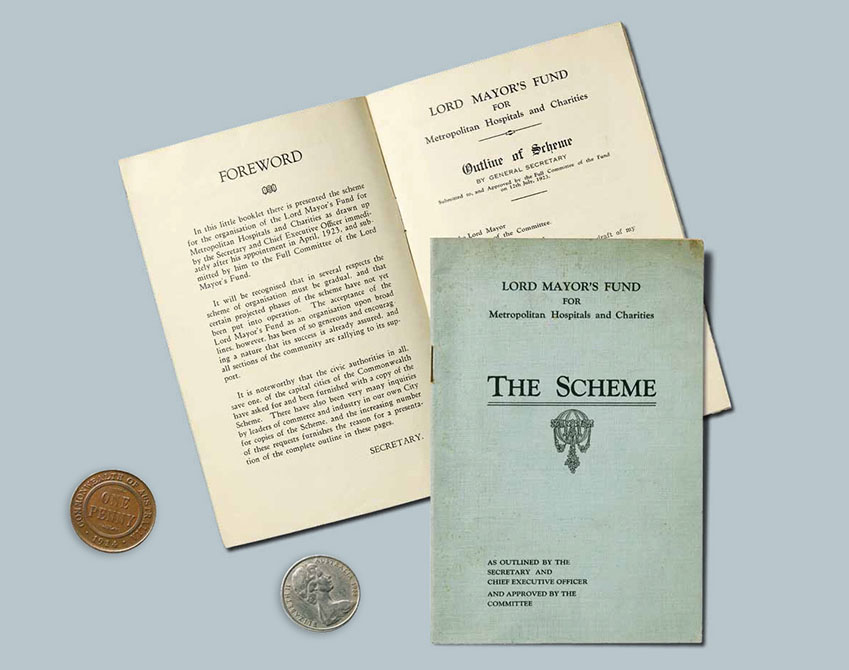Early Workplace Giving - Industrial Contributions Scheme
The Executive Committee of The Lord Mayor’s Fund for Metropolitan Hospitals and Charities were ambitious. Within a year of the Fund’s establishment, they launched the Fund’s Industrial Contributions Scheme, a workplace giving program that would eventually enrol more than 140,000 people from Melbourne’s workforce.
The Fund had the full support of the Charities Board of Victoria which was keen to organise public donations in support for Melbourne’s hospitals. The plan was to partner with businesses in the manufacturing, logistics and retail sectors and trade unions to set-up regular workplace giving programs for their employees.
The employees’ funds would be collected from wages and donated directly to the Fund to support hospital maintenance. One penny per week was the agree donation. Management from participating businesses would often subside their employees’ contributions helping to boost fundraising. The Scheme also had the support from the Trades Hall Council. It was to become a highly successful fundraising source for the Fund.
"In several instances the firms have generously undertaken to subsidise annually the charitable contributions of their employees."
During the 1925 financial year, the Fund’s CEO Mr E. Glanville Hicks had visited 100 different industries, associations, and various committees to promote the Fund and its Industrial Contributions Scheme. One of the benefits for members was that the Scheme provided an exemption for members from contributing to other fundraising appeals held by hospitals and charities. 50,000 booklets had been distributed throughout the year, titled 'The Scheme' and ‘What is the Lord Mayor's Fund?'. 1500 businesses and associations had signed and the Scheme was well and truly underway.

The Industrial Contributions Scheme grew in popularity as the reputation of the Fund as a trusted manager of public funds increased. The Fund encouraged membership by also allowing members to nominate the hospital or charity of their choice to receive their contributions. Another first for community philanthropy as an early donor advised giving program! Page 14AR27. The Scheme’s growth prompted the Fund to employ two new staff to support the CEO with the management and promotion of the Scheme which resulted in 11,000 new members.
The Industrial Contributions Scheme continued to grow in membership providing much needed funds to support distributions to Melbourne’s hospitals for their maintenance requirements. Although the Fund’s reports in 1929 that income from the Scheme reached £8,000, the timber workers strike and 'widespread dislocation of industry' had an impact on further donations being received. It was also reported that 'industrial' really referred to 'regular and systematic' contributors' from all business sectors including 'banks, commercial and mercantile houses in the city'. The Fund Executive Committee hoped the new decade would bring further opportunities to expand the Scheme.
It was not long for The Fund recognise the adverse impact The Great Depression was having on Melbourne and its businesses.
The Industrial Scheme remains popular within the participating workplaces however there is a reduction in members contributing to the Scheme due to the 'depleted ranks of our industrial workers', and therefore fundraising revenue has declined. 'Our experience shows that the popularity of the scheme has in no way declined, but the depression which has overhung industrial activities throughout the year has circumscribed our efforts and diminished the result'.
Many participating businesses and members of the Fund's Scheme are foregoing their donations in favour of taking up collections in support of their own staff whose working hours had been reduced or dismissed. Many members suspend their contributions as a consequence of the economic depression. The Fund reports it hope that contributions will increase once the industrial depression has ended.
By the end of the 1930s the Industrial Contributions Scheme was extended to become a voluntary contributions scheme for employees from all sections of business and trades. Fundraising revenue continues to grow for the Fund attracting support from Myer, Coles, CUB, Victorian Railways Department, Foy and Gibson, London Stores, Tramways Board, Shell Company, and Buckley and Nunn.
During the war years, the Fund’s Executive Committee refrained from promoting the Scheme out of respect for household incomes and wartime charitable efforts. But Melbourne’s philanthropic nature meant that fundraising continued to reach and sometimes exceed targets. In 1943, £40,000 was raised from Scheme, 14,000 more than the previous year.
The concept of workplace giving and Melbourne’s reputation as a generous city was firmly place by the mid-1950s when Scheme ended.